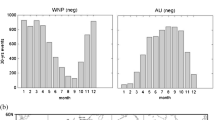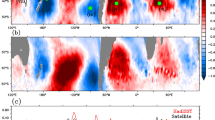Abstract
The dominant mode of July–August (JA) seasonal variability of Indian summer monsoon rainfall (ISMR) are obtained by performing empirical orthogonal function (EOF) analysis. The first dominant mode of ISMR and its relationships with the sea surface temperature (SST), pressure level wind and geopotential height (GPH) fields are examined using gridded datasets for the period 1979–2014. The principal component of the first leading mode (PC1) obtained in the EOF analysis of JA rainfall over Indian landmass is highly correlated with north-west and central India rainfall, and anti-correlated with east-equatorial Atlantic SST (EEASST). The positive EEASST anomaly intensifies the inter-tropical convergence zone over Atlantic and west equatorial Africa which generates stationary wave meridionally, as meridional transfer of energy is strong, as the influence of background jet-streams are minimal over North Africa and Europe. The anomalous positive and negative GPH are generated over sub-tropics and extra-tropics, respectively, due to the stationary wave. This increases the climatological background steep pressure gradient between sub-tropics and extra-tropics consisting of anomalous negative GPH field over north-west (NW) Europe and vice versa for negative EEASST anomaly. The anomalous positive GPH over NW Europe acts as center of action for the propagation of a Rossby wave train to NW India via Europe consisting of anomalous high over NW of India. This intensifies the Tibetan High westward which reinforces the outbreak of monsoon activities over central and NW India.








Similar content being viewed by others
References
Adler RF, Huffman GL, Chang A et al (2003) The version-2 global precipitation climatology project (GPCP) monthly precipitation analysis (1979-present). J Hydrometeor 4(6):1147–1167
Angell JK (1981) Comparison of variations in atmospheric quantities with sea surface temperature variations in the equatorial Pacific. Mon Weather Rev 109:230–243
Annamalai H, Liu P (2005) Response of the Asian summer monsoon to changes in El Nin˜o properties. Q J R Meteorol Soc 131:805–831
Bamzai AS, Shukla J (1999) Relationship between Eurasian snow cover, snow depth, and the Indian summer monsoon: an observational study. J Clim 12:3117–3132
Barimalala R, Bracco A, Kucharski F (2012) The representation of the South Tropical Atlantic teleconnection to the Indian Ocean in the AR4 coupled models. Clim Dyn 38:1147–1166. doi:10.1007/s00382-011-1082-5
Blanford HH (1884) On the connection of Himalayan snowfall and seasons of drought in India. Proc R Soc Lond 37:3–22
Branstator G (2002) Circumglobal teleconnections, the jet stream waveguide, and the North Atlantic Oscillation. J Clim 15:1893–1910
Chen T-C (2003) Maintenance of summer monsoon circulations: a planetary perspective. J Clim 16:2022–2037
Dee DP et al (2011) The ERA-Interim reanalysis: configuration and performance of the data assimilation system. Q J R Meteorol Soc 137:553–597
Ding Q, Wang B (2007) Intraseasonal teleconnection between the summer Eurasian wave train and the Indian Monsoon. J Clim 20:3751–3767
Enfield D, Mayer D (1997) Tropical Atlantic sea surface temperature variability and its relation to El Niño-Southern oscillation. J Geophys Res 102:929–945. doi:10.1029/96JC03296
Giannini A, Saravanan R, Chang P (2003) Oceanic forcing of Sahel rainfall on interannual to interdecadal time scales. Science 302:1027–1030
Gill AE (1980) Some simple solutions for heat-induced tropical circulations. Q J Roy Meteor Soc 106:447–462
Goswami BN, Krishnamurthy V, Annamalai H (1999) A broad-scale circulation index for the interannual variability of the Indian summer monsoon. Q J M R S 125:611–633
Goswami BN, Madhusoodanan MS, Neema CP, Sengupta D (2006a) A physical mechanism for North Atlantic SST influence on the Indian summer monsoon. Geophys Res Lett 33:L02706. doi:10.1029/2005GL024803
Goswami BN, Venugopal V, Sengupta D, Madhusoodanan MS, Prince KX (2006b) Increasing trend of extreme rain events over india in a warming environment. Science 314:1442–1445
Graham NE (1994) Decadal-scale climate variability in the tropical and North Pacific during the 1970s and 1980s: observations and model results. Clim Dyn 10:135–162
Hahn D, Shukla J (1976) An apparent relationship between Eurasian snow cover and Indian monsoon rainfall. J Atmos Sci 33:2461–2462
Held IM, Panetta RL, Pierrehumbert RT (1985) Stationary external Rossby waves in vertical shear. J Atmos Sci 42:865–883
Hu ZZ, Huang B (2007) Physical processes associated with the tropical Atlantic SST gradient during the anomalous evolution in the southeastern ocean. J Clim 20:3366–3378
Huang B, Schopf P, Shukla J (2004) Intrinsic ocean-atmosphere variability in the tropical Atlantic Ocean. J Clim 17:2058–2077
Janicot S, Harzallah A, Fontaine B, Moron V (1998) West African monsoon dynamics and eastern equatorial Atlantic and Pacific SST anomalies. J Clim 11:1874–1882
Kripalani RH, Kulkarni A (1996) Assessing the impacts of El Nino and non—El Nino related droughts over India. Drought Netw News 8:11–13
Kripalani RH, Kulkarni A (1999) Climatology and variability of historical Soviet snow depth data: some new perspectives in Snow-Indian monsoon teleconnections. Clim Dyn 15:475–489
Krishna Kumar K, Rajagopalan B, Cane MA (1999) On the weakening relationship between the Indian monsoon and ENSO. Science 284:2156–2159
Krishna Kumar K, Rajagopalan B, Hoerling M, Bates G, Cane M (2006) Unraveling the mystery of Indian monsoon failure during El Niño. Science 314:115–119
Krishnamurthy L, Krishnamurthy V (2014) Influence of PDO on South Asian summer monsoon and monsoon-ENSO relation. Clim Dyn 42:2397–2410. doi:10.1007/s00382-013-1856-z
Krishnamurthy L, Krishnamurthy V (2015) Teleconnections of Indian monsoon rainfall with AMO and Atlantic tripole. Clim Dyn. doi:10.1007/s00382-015-2701-3
Krishnan R, Sugi M (2003) Pacific decadal oscillation and variability of the Indian summer monsoon rainfall. Clim Dyn 21:233–242
Krishnan R, Kumar V, Sugi M, Yoshimura J (2009) Internal feedbacks from monsoon–midlatitude interactions during droughts in the Indian summer monsoon. J Atmos Sci 66:553–578. doi:10.1175/2008JAS2723.1
Kucharski F, Bracco A, Yoo J, Molteni F (2007) Low-frequency variability of the Indian Monsoon-ENSO relationship and the Tropical Atlantic: the weakening of the 1980s and 1990s. J Clim 20:4255–4266
Kucharski F, Bracco A, Yoo J, Molteni F (2008) Atlantic forced component of the Indian monsoon interannual variability. Geophys Res Lett 35:L04706. doi:10.1029/2007GL033037
Kucharski F, Bracco A, Yoo J, Tompkins A, Feudale L, Ruti P, Dell’Aquila A (2009) A simple Gill-Matsuno-type mechanism explains the tropical atlantic influence on African and Indian Monsoon rainfall. Q J Roy Meteor Soc 135:569–579. doi:10.1002/qj.406
Kucharski F, Bracco A, Barimalala R, Yoo JH (2010) Contribution of the eastwest thermal heating contrast to the South Asian Monsoon and consequences for its variability. Clim Dyn. doi:10.1007/s00382-010-0858-3
Mak M-K (1975) The monsoonal mid-tropospheric cyclogenesis. J Atmos Sci 32:2246–2253
Miller FR, Keshavamurthy RN (1968) Structure of an Arabian Sea summer monsoon system, I.I.O.E. Meteorological Monograph1, (East-West Center Press, Honolulu), 94
New M, Hulme M, Jones P (1999) Representing twentieth century spacetime climate variability. Part 1: development of a 1961–1990 mean terrestrial climatology. J Clim 12:829–856
Nobre P, Shukla J (1996) Variations of sea surface temperature, wind stress, and rainfall over the tropical Atlantic and South America. J Clim 9:2464–2479
Pai DS, Rajeevan M (2009) Summer monsoon onset over Kerala: new definition and prediction. J Earth Syst Sci 118(2):123–135
Parthasarathy B, Munot AA, Kothawale DR (1995) All India monthly and seasonal rainfall series: 1871–1993. Theor Appl Climatol 49:217–224
Rajeevan M, Bhate J, Kale JD, Lal B (2006) High resolution daily gridded rainfall data for the Indian region: analysis of break and active monsoon spells. Curr Sci 91:296–306
Rajeevan M, Gadgil S, Bhate J (2008) Active and break spells of Indian summer monsoon, NCC Research Rep. 7, India Meteorological Department, Pune
Raman CRV, Rao YP (1981) Blocking highs over Asia and monsoon droughts over India. Nature 289:271–273
Ramaswamy C (1962) Breaks in the Indian summer monsoon as a phenomenon of interaction between the easterly and the sub-tropical westerly jet streams. Tellus 14(3):337–349. doi:10.1111/j.2153-3490.1962.tb01346.x
Rasmusson EM, Carpenter TH (1983) The relationship between eastern equatorial Pacific sea surface temperature and rainfall over India and Sri Lanka. Mon Weather Rev 111:517–528
Rodwell MJ, Hoskins BJ (2001) Subtropical anticyclones and summer monsoons. J Clim 14:3192–3211
Ropelewski CF, Halpert MS (1987) Global and regional scale precipitation patterns associated with the El Nino/southern oscillation. Mon Weather Rev 115:1606–1626
Ropelewski CF, Halpert MS (1989) Precipitation patterns associated with the high index phase of the southern oscillation. J Clim 2:268–284
Saji NH, Goswami BN, Vinayachandran PN, Yamagata T (1999) A dipole mode in the tropical Indian Ocean. Nature 401:360–363
Shanahan TM, Overpeck J, Anchukaitis K, Beck J, Cole J, Dettman DL, Scholz C, King J (2009) Atlantic forcing of persistent drought in West Africa. Science 324:377–380. doi:10.1126/science.1166352
Shukla J (1987) Interannual variability of monsoon. In: Fein JS, Stephens PL (eds) Monsoons. Wiley, New York, pp 399–464
Sikka DR (1980) Some aspects of the large-scale fluctuations of summer monsoon rainfall over India in relation to fluctuations in the planetary and regional scale circulation parameters. Proc Ind Acad Sci (Earth Planet Sci) 89:179–195
Takaya K, Nakamura H (2001) A formulation of a phase-independent wave-activity flux for stationary and migratory quasigeostrophic eddies on a zonally varying basic flow. J Atmos Sci 58(6):608–627
Torrence C, Webster PJ (1999) Interdecadal changes in the ENSO–monsoon system. J Clim 12:2679–2690
Trenberth KE, Hurrell JW (1994) Decadal atmosphereocean variations in the Pacific. Clim Dyn 9:303–319
Vizy EK, Cook K (2001) Mechanisms by which the Gulf of Guinea and eastern North Atlantic sea surface temperature anomalies can influence African rainfall. J Clim 14:795–821
Webster PJ, Moore AM, Loschnigg JP, Leben RR (1999) Coupled ocean-atmosphere dynamics in the Indian Ocean during 1997–98. Nature 401:356–360
Yadav RK (2009a) Changes in the large-scale features associated with the Indian summer monsoon in the recent decades. Int J Climatol 29:117–133. doi:10.1002/joc.1698
Yadav RK (2009b) Role of equatorial central Pacific and northwest of North Atlantic 2-metre surface temperatures in modulating Indian summer monsoon variability. Clim Dyn 32:549–563. doi:10.1007/s00382-008-0410-x
Yadav RK (2012) Why is ENSO influencing India north-east monsoon in the recent decades? Int J Climatol 32:2163–2180. doi:10.1002/joc.2430
Yadav RK (2013) Emerging role of Indian ocean on Indian northeast monsoon. Clim Dyn 41:105–116. doi:10.1007/s00382-012-1637-0
Yadav RK, Rupa Kumar K, Rajeevan M (2009a) Increasing influence of ENSO and decreasing influence of AO/NAO in the recent decades over northwest India winter precipitation. J Geophys Res 114:D12112. doi:10.1029/2008JD011318
Yadav RK, Rupa Kumar K, Rajeevan M (2009b) Out-of-phase relationships between convection over north-west India and warm-pool region during winter season. Int J Climatol 29:1330–1338. doi:10.1002/joc.1783
Yadav RK, Yoo JH, Kucharski F, Abid MA (2010) Why is ENSO influencing northwest India winter precipitation in recent decades? J Clim 23:1979–1993. doi:10.1175/2009JCLI3202.1
Zhang R, Delworth TL (2006) Impact of Atlantic multidecadal oscillations on India/Sahel rainfall and Atlantic hurricanes. Geophys Res Lett 33:L17712. doi:10.1029/2006GL026267
Acknowledgments
The author wish to thank to the Editor and two anonymous reviewers for their insightful comments that helped improving the manuscript. The data have been taken from Web sites and all data sources are duly acknowledged. Computational and graphical analyses required for this study have been completed with the free softwares xmgrace, NCL and Ferret.
Author information
Authors and Affiliations
Corresponding author
Rights and permissions
About this article
Cite this article
Yadav, R.K. On the relationship between east equatorial Atlantic SST and ISM through Eurasian wave. Clim Dyn 48, 281–295 (2017). https://doi.org/10.1007/s00382-016-3074-y
Received:
Accepted:
Published:
Issue Date:
DOI: https://doi.org/10.1007/s00382-016-3074-y




